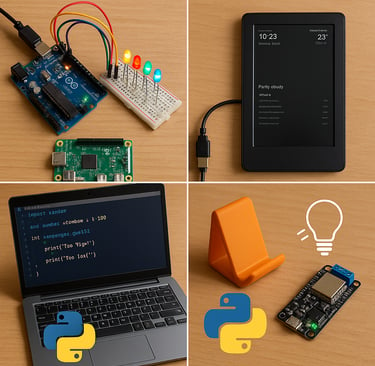
Dive into Tech
Just dive in to tech to help you learn
Shane Brown
5/10/20254 min read


Dive into Tech: 5 Beginner-Friendly DIY Projects to Spark Your Inner Maker
Embarking on a DIY tech project is like assembling a puzzle where every piece unlocks a new skill. Whether you’re curious about coding, fascinated by hardware, or eager to blend creativity with technology, these five projects offer a perfect entry point. Designed for absolute beginners, each project combines hands-on learning with real-world applications, ensuring you gain confidence while creating something tangible. Below, we’ll explore each project in detail, followed by a curated list of resources to fuel your journey-and yes, there’s a nerdy punchline waiting at the end.
Project 1: Arduino LED Light Show – Illuminate Your Coding Journey
What You’ll Learn: Basic electronics, circuit design, and introductory programming in C/C++.
Materials Needed:
Arduino Uno board
LEDs (multiple colors)
220-ohm resistors
Breadboard and jumper wires
Getting Started:
Begin by connecting an LED to the Arduino’s digital pin via a resistor. The built-in LED on pin 13 is a great starting point. Write a simple script to make it blink, then expand to multiple LEDs for a light sequence. For visual learners, The Robotics Back-End offers a step-by-step tutorial on wiring and coding, while YouTube channels like The 3D Printing Zone demonstrate sequential LED control using delays and loops.
Pro Tip: Start with the Arduino Starter Kit (includes 15 projects) or the budget-friendly Vilros Arduino Uno 3 Kit. Both come with guides that transform abstract concepts into playful experiments.
Project 2: Raspberry Pi Magic Mirror – Reflect Your Tech Curiosity
What You’ll Learn: Linux basics, Python scripting, and hardware-software integration.
Materials Needed:
Raspberry Pi 4 or 5
Two-way mirror
Monitor or display
Motion sensor (optional)
Getting Started:
Install the MagicMirror² software on your Raspberry Pi OS, then configure modules to display weather, calendars, or news. The MagicMirror.builders community provides open-source modules and troubleshooting tips. For a guided walkthrough, Ty and Gig Builds on YouTube breaks down assembly, from 3D-printing the frame to coding automatic display shutoffs using motion sensors.
Pro Tip: The Raspberry Pi for Beginners pathway on projects.raspberrypi.org offers free courses to demystify Linux commands and Python basics.
Project 3: Python Number Guessing Game – Code Your First Victory
What You’ll Learn: Programming logic, conditional statements, and user input handling.
Materials Needed:
A computer with Python installed
Text editor (VS Code or Thonny)
Getting Started:
Write a script that generates a random number between 1 and 100, then prompts the user to guess it. Add hints like “Too high!” or “Too low!” to guide players. Inspirit AI and freeCodeCamp provide sample code and challenges to expand your game with score tracking or difficulty levels.
Pro Tip: Strengthen your skills with Codecademy’s Learn Python 3 course or Dr. Charles Severance’s Python for Everybody on Coursera-both emphasize hands-on practice.
Project 4: 3D Printed Phone Stand – Craft Functionality Layer by Layer
What You’ll Learn: 3D design principles, slicing software, and material selection.
Materials Needed:
3D printer (e.g., Bambu Lab X1 Carbon)
PLA filament
Tinkercad or Fusion 360 software
Getting Started:
Design a minimalist phone stand in Tinkercad, focusing on倾斜 angles and stability. Export the model as an STL file, then slice it using OrcaSlicer to generate printer instructions. Platforms like Thingiverse and Printables host pre-made designs if you’d rather dive into printing first. The 3D Printing Zone on YouTube offers a 30-minute crash course on bed leveling, filament types, and troubleshooting common print failures.
Pro Tip: Overture PLA is a beginner-friendly filament known for its smooth texture and minimal warping.
Project 5: Smart Home Automation Starter – Upgrade Your Space with IoT
What You’ll Learn: IoT fundamentals, MQTT communication, and sensor integration.
Materials Needed:
ESP32 microcontroller
Relay module
Smart bulbs or plugs
Home Assistant software
Getting Started:
Use the ESP32 to create a Wi-Fi-enabled switch that controls lights via voice commands or a mobile app. The Home Assistant platform lets you unify devices from different brands into a single dashboard. For eco-conscious makers, LabProjectsBD highlights trends like solar-powered sensors and energy monitors using recycled components.
Pro Tip: Start with ESPHome, a framework that simplifies coding for ESP boards, and explore Node-RED for drag-and-drop automation workflows.
Curated Resources for Aspiring Makers
Learning Platforms & Communities
Arduino.cc: Official tutorials, project ideas, and forums.
Corey Schafer’s YouTube Channel: In-depth Python tutorials with real-world examples.
Raspberry Pi Forums: Beginner-friendly support for hardware and software hurdles.
The 3D Printing Zone: YouTube guides on printers, slicers, and design tools.
Starter Kits & Tools
Elegoo Mega 2560 Kit: 25 projects spanning robotics and smart home tech.
Bambu Lab X1 Carbon: Multi-material 3D printer for advanced creations.
FutureLearn’s Raspberry Pi Course: Three-week program blending theory and practice.
Inspirational Hubs
Instructables: DIY project blueprints for all skill levels.
Hackster.io: Open-source IoT prototypes with code snippets.
dev.to: Developer blogs sharing triumphs and tribulations.
Conclusion: Your Journey Starts with a Single Circuit
The beauty of DIY tech lies in its power to transform “I can’t” into “I built this.” Each project above is a stepping stone-a chance to solder a connection, debug a script, or marvel at a 3D printer’s hum. As you progress, remember that even seasoned engineers once fumbled with resistor values or syntax errors. So grab a kit, document your wins (and mishaps), and share your story. Who knows? Your blog might just inspire the next generation of makers.
Nerd Joke of the Day:
Why don’t programmers ever get lost in the forest?
Because they always follow the path traversal algorithm!
Now go forth and debug the world-one project at a time.
